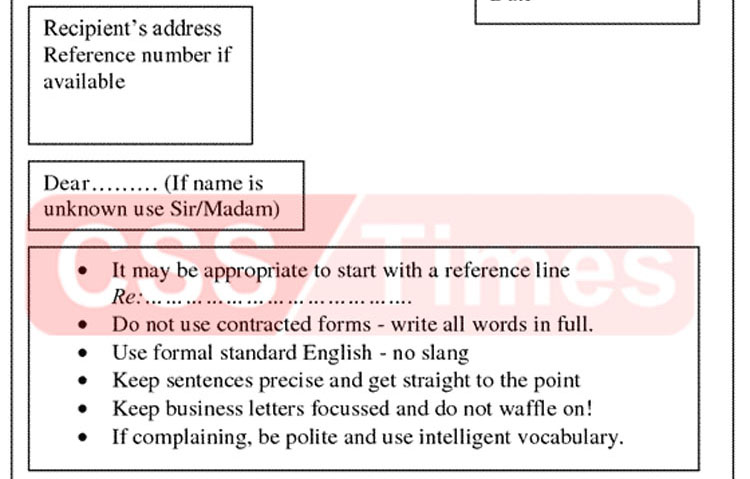The Punjab PMS exam is going to be held from 7 April. Due to a barrage of requests I received on social media regarding letter writing in PMS exam, I have made up my mind to write on this issue on CSS Times for facilitating the aspirants collectively. A formal letter in the Punjab PMS exam is addressed to higher authorities, dignitaries, colleagues, and seniors. The language is academic and formal, following the salient features of writing norms. It is different from letters we write in our daily life to our close friends, family and relatives.
Pattern/Template/Format of a Formal Letter
It is possible to writing official letters in different styles. Without following principles of academic writing, letter writing a futile exercise .Keeping in view the ironclad, watertight dynamics of letter writing in PMS exam, the following vitally significant characteristics should be followed in true letter and spirit.
- Sender’s address
- Date
- Name / Designation of Addressee
- Address of the Addressee
- Salutation
- Subject
- Body – Introduction, Content, Conclusion
- Complimentary Close
- Signature / Name of the Sender
- Designation of the Sender
Sender’s Address
Sender’s address is important and should be written carefully
- It is usually put on the top right-hand corner of answer sheet
- In order to avoid inconvenience, the address should be complete and accurate
- This will facilitate the recipient for further, meaningful communication with the sender
Date
Why date is important in formal letter writing? Official letters are often kept on record for better management of governance.
Write date on the right side of the page just below the Sender’s address.
Format of date in letter writing
- 7 April, 2018
- 7 April 2018
- 07/04/2018
- April 7,2018
Receiver’s Address
Try to write the receiver’s address on the left side of the page. It is spot on to mention here that make sure you write the official title/name/position, etc., of the receiver, as the first line of the address.
Salutations/Greeting
The person being addressed is greeted. Greetings should be respectful and not informal and personal. The general greetings used in formal letters are “Sir” or “Madam”(The Rev.Sir,The Rev.Madam).
In case one know the names of the authorities concerned, the salutation may also be “Mr. XYZ” or “Ms. ABC”. It is pertinent to keep in mind one cannot address them only by their first name. It must be the full name or only their last name.
Subject
Directly after the salutations, one should write the subject of the letter. It is recommended to write it in the center of the line. It goes like “Subject” followed by a colon. Then we sum up the purpose of writing the letter in one line. This helps the receiver focus on the subject of the letter in one glance.
Body of the Letter
- Body of the letter like an essay is the main content of the letter.
- In formal letter writing it is either divided into three paragraphs or two paragraphs
- In order to capture the attention of the person addressed, the purpose of the letter should be made clear in the first paragraph itself.
- The tone and tenor (the narrative you describe) of the content should be formal.
- No need to use bombastic, heightened or any flowery language.
- It should be concise and to the point rather than lengthy and difficult.
- For making sure your letter could be impactful and effective, try to be respectful and considerate in your language, no matter the subject of your letter.
Closing the Letter
Write complementary phrases on the right side of the paper. These phrases include words like: “Yours Faithfully” or “Yours Sincerely” . Generally, use “Yours Faithfully” if the writer knows the name of the person.
Signature
Why this part is important?
- First sign your name.
- Second write your name in block letters beneath the signature.
- As a matter of convenience, this is how the recipient will know who is sending the letter.
